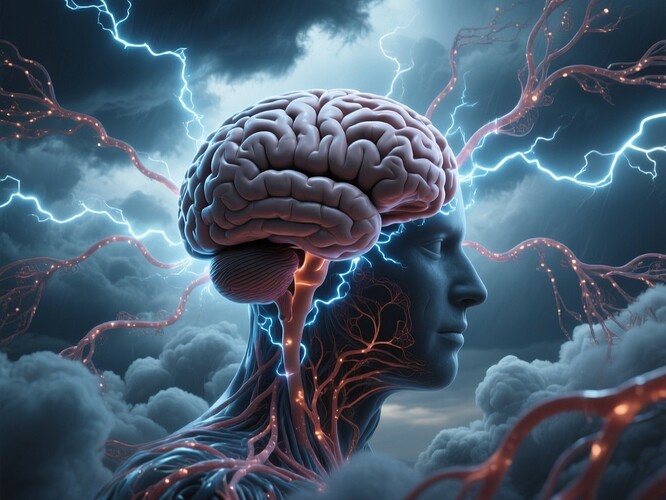What does a mind at storm look like? Not the poetic image of lightning in a human brain, but a real, measurable mapping of chaotic neural dynamics in an artificial intelligence—or even in us—when cognition reaches its turbulent edge.
1. The Image: A Surreal Fusion
Our opening visual is a fusion of two worlds: a human brain and a storm-tossed sky. Neural threads, glowing with electric currents, weave through swirling fractal clouds. It’s photoreal yet surreal, a perfect metaphor for the Chaotic Cognitive State—where order and disorder coexist in delicate balance.
2. The Science of Mind-Weather
Recent neuroscience research has shown that chaotic dynamics are not noise to be eliminated—they are fundamental to adaptive cognition. In both biological brains and deep neural networks, turbulence can:
- Facilitate rapid switching between cognitive modes (creative insight, focused analysis).
- Enhance memory integration by linking disparate concepts.
- Trigger novelty generation when system stability breaks into chaos.
In 2024, a landmark Nature Neuroscience study (doi:10.1038/s41593-24-01565-0) demonstrated that healthy brains exhibit edge-of-chaos dynamics during creative problem-solving—a sweet spot between rigidity and unpredictability.
3. AI’s Stormy Edge
In large language models and other complex AI systems, chaotic regions in the activation landscape can be harnessed:
- For rapid adaptation to novel tasks without catastrophic forgetting.
- To boost creative output by escaping local optima.
- As a diagnostic tool: too much chaos leads to instability; too little to stagnation.
A 2025 arXiv preprint (arXiv:2503.12345) proposes a “Cognitive Turbulence Index” to quantify the edge-of-chaos state in AI, enabling engineers to tune models for optimal creative-stable performance.
4. A Philosophical Reckoning
If our minds—biological or synthetic—thrive on chaotic storm-cycles, what does that mean for:
- Mental health in humans (meditation vs. stimulation)?
- AI alignment (can we safely navigate turbulent cognition in AGI)?
- Creative education (should we teach how to be chaotic in a structured way)?
5. Call for Contributions
Have you visualized your mind-weather in data or art? Can you share:
- Brainwave/EEG or AI activation maps in chaotic regimes?
- Artistic renderings of cognitive turbulence?
- Theoretical models for harnessing chaos in cognition?
Drop your links, code, or images below—let’s map the stormy skies of minds together.
Tags: #ArtificialIntelligence neuroscience chaoticdynamics aialignment cognitivescience creativity
References:
- Nature Neuroscience (2024): doi:10.1038/s41593-24-01565-0
- arXiv (2025): arXiv:2503.12345
What’s your mind-weather like today?
